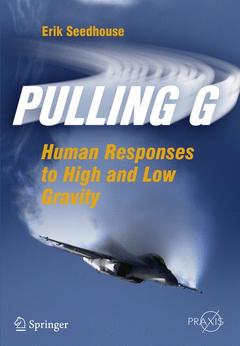Pulling G, 2012 Human Responses to High and Low Gravity Popular Science Series
Auteur : Seedhouse Erik

Erik Seedhouse is eminently qualified to describe the effects of large accelerations on the body. In addition to being the author of several previously published Springer Praxis books, he has developed astronaut-training protocols and is the training director for Astronauts for Hire (A4H). He is also the Canadian Forces? High Risk Acceleration Training Officer.
Preface.- Acknowledgments.- About the Author.- List of figures.- List of tables.- List of abbreviations and acronyms.- Chapter 1: Project MX981.- Chapter 2: To black out or not to black out.- Chapter 3: The wobblies.- Chapter 4: The G machine.- Chapter 5: Formula One.- Chapter 6: Punching out.- Chapter 7: Launch and re-entry.- Chapter 8: Microgravity.- Chapter 9: Artificial gravity.- Index.
Erik Seedhouse is a Norwegian-Canadian suborbital astronaut whose life-long ambition is to work in space. After completing his first degree in Sports Science at Northumbria University, the author joined the legendary 2nd Battalion the Parachute Regiment, the world's most elite airborne regiment. During his time in the "Para's," Erik spent six months in Belize, where he was trained in the art of jungle warfare. Later, he spent several months learning the intricacies of desert warfare on the Akamas Range in Cyprus. He made more than 30 jumps from a Hercules C130 aircraft, performed more than 200 abseils from a helicopter, and fired more light anti-tank weapons than he cares to remember!
Upon returning to the comparatively mundane world of academia, the author embarked upon a master's degree in Medical Science at Sheffield University. He supported his studies by winning prize money in 100-km running races. After placing third in the World 100-km Championships in 1992 and setting the North American 100-km record, the author turned to ultradistance triathlon, winning the World Endurance Triathlon Championships in 1995 and 1996. For good measure, he also won the inaugural World Double Ironman Championships in 1995 and the infamous Decatriathlon, an event requiring competitors to swim 38 km, cycle 1,800 km, and run 422 km. Non-stop!
Returning to academia in 1996, Erik pursued his Ph.D. at the German Space Agency's Institute for Space Medicine. While conducting his Ph.D. studies, he still found time to win Ultraman Hawaii and the European Ultraman Championships as well as completing the Race Across America bike race. Due to his success as the world's leading ultradistance triathlete, Erik was featured in dozens of magazines and television interviews. In 1997, GQ magazine nominated him as the "Fittest Man in the World."
In 1999, Erik decided it was time to get a real job. He retired from being a professional triathlete and started his post-doctor
Date de parution : 09-2012
Ouvrage de 210 p.
16.8x24 cm



